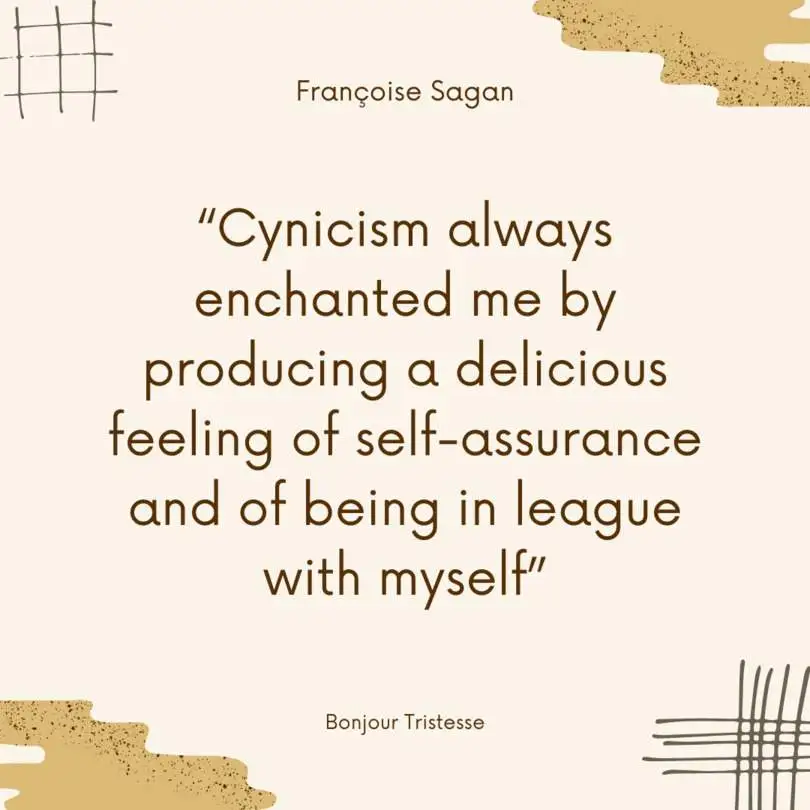“Bonjour Tristesse” by Françoise Sagan: A Exploration of Youth, Desire, and the Complexities of Love
Françoise Sagan‘s “Bonjour Tristesse” is not just a novel; it’s a hypnotic dive into the tumultuous world of youth, desire, and the intricacies of love.’s “Bonjour Tristesse” is not just a novel; it’s a hypnotic dive into the tumultuous world of youth, desire, and the intricacies of love. As readers are swept away by the sun-soaked French Riviera, the story unfolds with an alluring blend of sophistication and raw emotion, leaving an indelible mark on the literary landscape. Brace yourself for a journey through the heady days of summer, where the line between pleasure and pain blurs, and the consequences of youthful decisions linger like the fading echoes of laughter.
The Allure of the Riviera: A Sun-Drenched Backdrop
Before delving into the narrative, one cannot ignore the allure of the setting in “Bonjour Tristesse.” The French Riviera, with its azure waters, glamorous lifestyle, and languid summer days, becomes more than a backdrop; it is a character in its own right. Sagan’s evocative prose transports readers to a world of opulence and hedonism, where the scents of the Mediterranean breeze and the rhythmic sounds of waves crashing on the shore create a sensory tapestry.
The Riviera’s intoxicating atmosphere becomes a reflection of the characters’ emotional states, mirroring the highs and lows of their relationships. Sagan masterfully weaves the setting into the fabric of the narrative, infusing it with an ambiance that is both seductive and melancholic—a microcosm of the novel’s themes.

Protagonist: Cécile, a Portrait of Adolescent Ambiguity
At the heart of “Bonjour Tristesse” is the complex and enigmatic character of Cécile, a seventeen-year-old girl navigating the murky waters of adolescence. Sagan presents Cécile as a protagonist whose narrative voice is simultaneously precocious and naive. Through her introspective musings, readers gain access to the inner workings of a mind grappling with desire, rebellion, and the awakening of adult emotions.
Cécile’s character is a study in contradictions. On one hand, she exudes a veneer of sophistication, indulging in the pleasures of the Riviera’s social scene. On the other hand, her vulnerability and insecurities expose the fragility of youth. Sagan crafts a nuanced portrayal of a young woman on the cusp of maturity, exploring the duality of her nature as she navigates the complexities of love and familial relationships.
Themes in “Bonjour Tristesse”: Love, Desire, and the Shifting Sands of Morality
“Bonjour Tristesse” is a narrative that delves into the multifaceted nature of love and desire. The novel’s title, translating to “Hello Sadness,” sets the tone for an exploration of the emotional landscape where joy and sorrow coexist. Sagan ventures into the realms of passionate love affairs, the transient nature of desire, and the blurred boundaries between societal norms and personal fulfillment.
The central conflict revolves around Cécile’s relationship with her father, Raymond, and the introduction of Anne, a sophisticated woman who disrupts the delicate equilibrium of their lives. Sagan provocatively examines the morality of love and the consequences of unrestrained desire, inviting readers to question societal expectations and the complexities of human relationships.
Narration: A Mélange of Reflection and Impulse
Sagan’s narrative style in “Bonjour Tristesse” is a captivating blend of reflection and impulse, mirroring the dichotomy within the characters. Cécile’s introspective and often contemplative voice provides a window into her thoughts, exposing the raw emotions that underlie her actions. The prose is imbued with a lyrical quality that heightens the novel’s emotional impact, capturing the fleeting intensity of youth.
The narrative oscillates between past and present, weaving a tapestry of memories and immediate experiences. Sagan’s temporal shifts create a sense of fluidity, reflecting the characters’ transient emotional states. This narrative technique serves as a mirror to the ephemeral nature of the characters’ relationships and the impermanence of youth.
Supporting Characters in “Bonjour Tristesse”: A Gallery of Complexities
Beyond Cécile, “Bonjour Tristesse” introduces a cast of supporting characters, each contributing to the narrative’s rich tapestry. Raymond, Cécile’s father, is portrayed as a charismatic and self-indulgent figure whose actions catalyze the unfolding drama. Anne, the sophisticated woman who enters their lives, adds an element of tension and intrigue. The supporting cast is rounded out by Elsa, a family friend, and Cyril, a young man entangled in the web of Cécile’s desires.
Sagan crafts characters who defy easy categorization, infusing them with complexities that mirror the nuances of real-life relationships. Each character becomes a vessel for exploring different facets of love, morality, and the human capacity for both selfishness and selflessness.
Youthful Rebellion: A Prelude to Adulthood
The theme of youthful rebellion is a prominent thread in “Bonjour Tristesse,” as Cécile grapples with the constraints of societal expectations and familial obligations. Sagan captures the heady sense of liberation that comes with youth, as well as the consequences of unbridled rebellion. Cécile’s actions, driven by a desire for autonomy and self-expression, become a prelude to the inevitable transition into adulthood.
The novel becomes a coming-of-age tale that transcends the boundaries of a single summer, encapsulating the broader journey of self-discovery and the reckoning with the consequences of one’s choices. Sagan navigates the complexities of adolescence with sensitivity, offering readers a glimpse into the universal experience of navigating the tumultuous waters between childhood and maturity.

Criticisms: A Tumultuous Elegance
While “Bonjour Tristesse” has been celebrated for its elegance and emotional depth, it is not immune to criticism. Some readers may find the characters’ behaviors and moral ambiguities challenging or unsettling. The novel’s exploration of taboo subjects and its unapologetic portrayal of desire may be provocative for those who prefer more conventional narratives.
Additionally, the brevity of the novel, while contributing to its impact, may leave some readers yearning for further exploration of certain themes and characters. Sagan’s succinct storytelling, while a strength, may be perceived as a limitation for those seeking a more expansive narrative.
Legacy: A Timeless Exploration of Passion and Regret
“Bonjour Tristesse” remains a seminal work in French literature, admired for its exploration of passion, morality, and the complexities of human relationships. Sagan’s ability to capture the ephemeral beauty of youth and the consequences of unrestrained desire has left an indelible mark on the literary landscape.
The novel’s legacy extends beyond its initial publication, influencing subsequent generations of writers and readers. Sagan’s unflinching portrayal of youthful emotions, coupled with the novel’s timeless themes, ensures its place as a classic that continues to resonate with those drawn to narratives of love, rebellion, and the bittersweet symphony of human existence.
Conclusion “Bonjour Tristesse”: An Ode to Youth, Desire, and the Pangs of Love
In conclusion, “Bonjour Tristesse” by Françoise Sagan is an exquisite tapestry of emotions—a vivid portrayal of youth, desire, and the complexities of love set against the sun-drenched backdrop of the French Riviera. Sagan’s narrative elegance, coupled with her exploration of moral ambiguity, creates a timeless work that continues to captivate readers.
As Cécile’s story unfolds, “Bonjour Tristesse” becomes more than a novel; it is an ode to the transient beauty of youth, a meditation on the consequences of passion, and a poignant exploration of the ever-shifting sands of love. Sagan’s literary prowess shines in this brief yet impactful work, leaving an indelible imprint on those who embark on the emotional journey it offers—a journey that lingers like the fading echoes of laughter on a summer day.